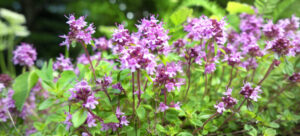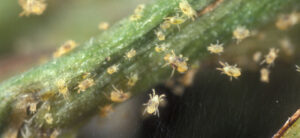
While they may not be as notorious as mites or aphids, you need to know how to get rid of grasshoppers fast if they infest your garden.
These destructive pests can cause extensive damage to your plants if left to colonize and feed.
As voracious feeders, these bugs can eat up to half their body weight in food in less than 24 hours. And your fresh, leafy green foliage is their meal of choice.
Both adult grasshoppers and nymphs have the potential to take down an entire garden. Luckily, there are some easy ways to eliminate these pests once you detect their presence.
In this article, we’ll tell you everything you need to know about how to identify, prevent, and if necessary, get rid of grasshoppers fast.
How To Tell You Have A Grasshopper Infestation
Grasshoppers can be found all over the world. The only place you won’t find them is in Antarctica. They eat all kinds of plants but prefer grasses and broadleaf plants in particular.
Unlike spider mites or aphids, their presence is pretty easy to detect. They are large enough that you can see them, and will likely move around as you get close to them, giving away their hiding spots.
Besides just visually seeing them, you can also see signs of their damage on your plants. Look for large holes in your foliage. This is a sign of them feasting on your plants.
Why Are Grasshoppers A Problem?

Grasshoppers can completely decimate a garden - regardless of the type. It doesn’t matter whether you are growing ornamental flowers, shrubs, vegetables, herbs, or fruits - grasshoppers are indiscriminate predators.
No matter where they are in their life cycles, they’ll gnaw away at the leaves and even the stem of all the plants in your garden.
This damage can be severe, in some cases, completely defoliating your plants and making it impossible for them to grow.
If you think you need a lot of grasshoppers to pose a threat, think again. As few as ten adults per yard can damage your garden, depending on what you are growing. In fact, a study showed that just six grasshoppers per square yard on ten acres of pasture ate as much as an entire cow.
That’s why finding their presence fast is so important, because by the time you have a full blown infestation, the damage will likely be done.
Not all species of grasshoppers are bad for the garden, but all the ones that are have a similar developmental cycle and behaviors.
Most lay their eggs at the end of the summer. These eggs hatch in the early spring. As soon as the eggs hatch, the nymphs will begin to consume plant matter.
How To Prevent Grasshoppers From Infesting Your Garden
One of the easiest ways to prevent grasshoppers from becoming a nuisance is to practice good gardening hygiene.
Make sure you clean all debris out of your garden out of the end of the season and mow tall grass on your lawn.
If you grow indoors, you shouldn’t have much of a problem with these guys. They’re big enough that they can only really get indoors if you leave windows or doors open, which is an indoor growing no-no.
If grasshoppers are getting inside your house, you may need to seal up exterior openings around doors, in window screens, and in door seals. Trim any vegetation, including that which has overhanging branches.

But, the best option is to use a grow tent. These will seal your grow off from the rest of your home, which has a number of benefits.
For one, it serves as an added layer of protection from pests. But, grow tents also seal the mess of your garden from the rest of your home - including soil and nutrient mishaps, odors, and the atmospheric conditions inside the tent. There truly is no better way to grow indoors.
But, if you are growing outdoors, there is only so much you can do. After all, grasshoppers are prominent in certain areas, and as flying bugs, they can come from far and wide to seek out your plants.
Get Rid Of Grasshoppers Naturally
There are chemicals that you can spray that will definitely get rid of grasshoppers safely and quickly, but some growers are still hesitant to use even organic pest control products.
So, we researched and found some methods that growers have used to naturally eliminate grasshoppers with completely natural products you may already have lying around the house.
Garlic Spray

If you don’t mind the smell, garlic is an effective organic tool for getting rid of grasshoppers.
Plus, it can provide a boost of nutrients to your soil.
Basically, garlic works by suffocating the small pests as they move around your plants.
All you have to do is make a simple garden spray. This might sound like a complicated process, but it's really not.
Combine six cloves of garlic with half a cup of mineral oil and five cups of water. Let the brew sit overnight.
Then, shake it before spraying it to the leaves of the plant as a foliar spray. If you have leftover spray, don’t worry - it can last up to two weeks if you store it in a cool, dry, and dark location.
Till and Cover Crop in the Fall
One of the easiest ways to prevent grasshoppers is to till your garden in the fall. Of course, this won’t work if grasshoppers are a problem on your perennial plants - you won’t be able to till around them.
However, if you find that grasshoppers recur each year on your new plantings, it’s probably because they are hatching out of overwintered eggs.
Tilling in the fall will bring those eggs up to the soil’s surface, and the cold autumn and winter air will destroy them.

They won’t be able to make it until the spring. For added protection, consider planting a fall cover crop in your garden after tilling.
This will protect the soil and make it less prone to weeds, disease, and of course, grasshoppers!If fall doesn’t work for your schedule, you can also till in the spring.
You’ll need to get on this chore early, though, as the eggs will hatch once the weather warms.
Flour Spray
Some gardeners swear by this organic method of controlling grasshoppers. It might make your garden look a little strange, but it’s highly effective.
Simply sprinkle a bit of all-purpose flour over the tops of your plants. You don’t need to douse them - just create a fine layer.
The flour will cascade downward over the leaves, leaving behind a dusty layer that will gum up the grasshoppers’ mouths and cause them to starve to death.
Plant Preventative Flowers and Vegetables
While grasshoppers are mostly indiscriminate in how they choose to feed, there are some flowers and vegetables that they aren’t fond of.
If you want to keep grasshoppers away, you might try planting some of the following species in or around your garden:
- Lilac
- Verbena
- Sage
- Jasmine
- Squash
- Peas
- Tomatoes
You might also try planting tall grass on the outskirts of your garden. When given the choice, grasshoppers prefer hanging out in tall grass.
This will provide them with a more suitable habitat, making them leave your garden alone.
Use Floating Row Covers
Floating row covers can be used as an emergency line of defense against garden predators.
These are simply fabric barriers that are held up with hoops or stakes, protecting the plants inside from pests like grasshoppers and aphids.
Diatomaceous Earth
Diatomaceous earth is one of the most common garden additives you can buy. It consists of fossilized algae shells and is completely safe to use around humans and animals.
It works by drying up the outside of a grasshopper’s body as soon as it comes into contact with it. Diatomaceous earth is effective on any soft-bodied insect and is applied as a dust.
You can also mix it with water and use it as a spray.
Chicken, Guinea Fowl, and Other Birds
You may be familiar with beneficial bugs and their role in the garden. But, here us out on this one: beneficial birds.
There are all kinds of animals that enjoy munching on grasshoppers. Consider adding a few chickens, guinea hens, or ducks to your backyard (if your lifestyle permits it).
If chickens are out of the question, you may want to add a wild bird feeder. These animals also enjoy chomping down on grasshoppers from time to time.
And for the most part, they have no interest in your plants. You won't have to worry about them munching on your foliage, they prefer insects.
Get Rid Of Grasshoppers With Pesticides & Insecticidal Soaps
If you don’t mind spraying pesticides or these natural methods above prove unfruitful, there are plenty of other options that are much more invasive, but will likely act quicker and more effectively.
From neem oil and plant washes to strong, OMRI listed insecticides, here are some last ditch efforts you can make to restore your garden to its original condition.
Neem Oil & Plant Washes
Neem oil is a natural insecticide that can remedy all kinds of plant diseases, molds, and insect outbreaks.
It is a natural plant extract, so you don’t have to worry about it doing any damage to pollinators or animals nearby.
All you need to do is spray it in your garden and wave goodbye to the hordes of grasshoppers that were plaguing you.
Many growers use these products preventively, spraying the foliage of their plants occasionally to discourage bugs from ever snacking in the first place. If you live in a higher danger area as far as pests go, this may be a great idea for you.
Pesticides To Get Rid Of Grasshoppers
A variety of pesticides and insecticides can be used in your fight to get rid of grasshoppers on your plants. There are plenty of safe options that pose no risk to you, children, pets, your plants, or the environment.
These products get a bad rep, but when used properly they can save your garden without compromising quality or safety. Here are some of the best ones for grasshoppers in particular:
- Fox Farm "Don't Bug Me" Pyrethrin Spray
- Monterey Garden Insect Spray with Spinosad
- Bonide Captain Jack's Deadbug Brew Concentrate
These products contain either spinosaid, pyrethrin, or both. These compounds will weaken the hard shell grasshoppers have, and damage them from the outside in.
As this occurs, they will end up leaving your plants alone, or dying. Either way, they will stop eating your garden!
Be Proactive Instead of Reactive to Get Rid of Grasshoppers
You’ve worked hard to cultivate a gorgeous garden, filled with lush flowers and delicious vegetables. Unfortunately, grasshoppers can be relentless in their destruction of all your hard work.
Therefore, it’s essential that you think carefully about pest removal strategies before grasshoppers and other pests become a problem.
By taking steps to prevent a pest infestation now, you’ll be able to enjoy the bounty of your garden to its fullest later on.
If you want to learn more, read our complete guide on pest and disease issues growers commonly experience.
If you need help finding a product for your garden or grow room, reach out to our experts at 888-815-9763 or by email here.
















